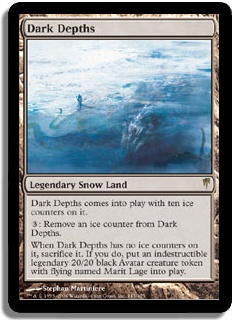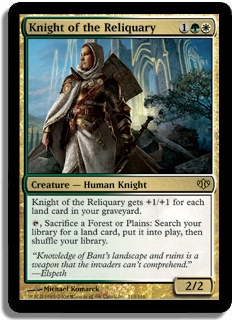By now I assume all of you have heard about the latest core set rules changes, but for those not "in the know" yet, you can find them here. I expect the changes to have a significant impact, especially in Eternal formats, so it shouldn’t come as a surprise that that impact is what I’ll be talking about today. Spoiler alert: I actually think most of these changes are awesome.
A short recap of the changes likely to be relevant for us:
- Legendary permanents and planeswalkers now only check your side of the board as far as uniqueness is concerned, so it’s fine for both of you to have a Thalia, Guardian of Thraben in play but not for you to have two of them on your own. Note that this also means cloning a legend doesn’t kill it anymore; you’ll just both have a copy.
- Whenever there are two "unique" permanents in play on the same side, the controller gets to choose which one is destroyed (instead of both going down).
- The game only remembers how many land drops were made and how many you’re allowed to make to figure out if you can still play a land—no bouncing your Explorations for fun and profit anymore.
- Your sideboard can now be any size from zero to fifteen cards at any time (so you can play game 1 with a classic 60/15 configuration but end up with 65/10 post-board if you wish).
The two other changes are unlikely to make big waves: indestructible is now a keyword (and therefore effected by stuff like Humility even if it was granted by, say, Boros Charm), while can’t be blocked/unblockable is clearly defined as a characteristic setting ability (which won’t be).
So far, so good; let’s start talking about what these changes mean!
Getting the Complaining Out of the Way
Even though I just said I really like what Wizards is doing to the rules for once, there obviously are a few things I don’t like, and I’d be remiss to not mention them
What I dislike the most about these changes is the flavor. Both legendary and planeswalker uniqueness were meant to represent the idea that a particular individual had been summoned from somewhere in the depths of the multiverse to help out the player doing the summoning.
The new rule really demolishes that flavor. If my helper is an individual, how can he be there more than once? And even if you find some convoluted explanation—say those being different incarnations summoned from different points of his personal timeline—how is it that I can’t actually summon a guy from multiple points in his timeline but my opponent can summon up someone who’s already working for me but also only once? Flavor-wise this is just a nightmare, honestly.
That being said, flavor is important, but good gameplay is even more so. As far as the rules are concerned, gameplay trumps flavor any day—and it should. Most people will play a game that has bad flavor but is incredibly fun. A bad game with awesome flavor, on the other hand, is going to have a much harder time retaining players.
Speaking of bad gameplay, a few situations have gotten quite a bit uglier. The biggest offenders here are hexproof creatures and Umezawa’s Jitte. Geist of Saint Traft; Sigarda, Host of Herons; and Thrun, the Last Troll were already annoying enough to get rid of when you could clone them—making them even harder to kill isn’t particularly helpful. Given how much that interaction actually comes up outside of Standard, though, there shouldn’t be a problem for Eternal formats here.
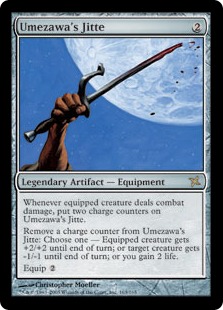
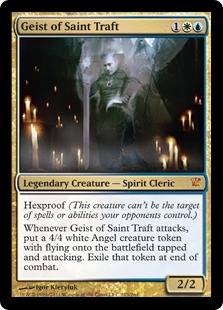
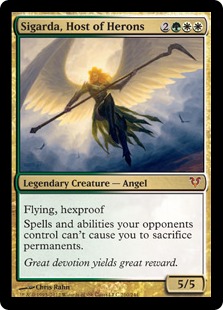
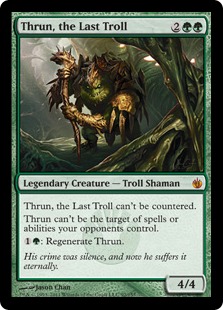
As for Jitte, before, you could always break out of the board lock that is an active Jitte by finding your own. Now, the player that gets Jitte online first is likely to just straight up win barring dedicated artifact removal. How often will you find something to actually carry your Jitte when your opponent’s is already locking down the board?
I expect the whole killing ridiculous legends problem to be significantly worse in Commander—where I believe cloning opposing commanders was an important tool to keep them in check—but given that I don’t play that format, this really isn’t something I can say much about.
Moving away from the whole uniqueness thing, I don’t think the keyword changes matter much, though there’s one thing I wonder about. How does Humility interact with an Elspeth, Knight-Errant emblem now?
The new land drop rule also won’t come up all that often, but it is clearly more intuitive and easier to keep track of as long as you weren’t used to the old way of doing things. Before, you had to figure out which land drops you had used—in particular special land drops like those from Explore and Exploration—to know if you could still play lands. Now, all you do is check how many lands you’ve played so far, check how many lands you’re currently allowed to play, and only as long as the second number is bigger than the first, you can still play lands. Much easier and cleaner, no question about it.
If I think this is actually a better rule, why do I have it among the negatives? Well, I personally like weird shenanigans you can pull because the rules work in a particular way, so I’m sad another sweet trick is gone now that you can’t reset your Exploration anymore. If I’m honest with myself, though, I know the game will be better for it.
The Sweet Things
"The legend rule now looks at each player individually."
Alright, here’s the first thing I thought when reading about the changes: we now get to play Jace mirrors where both players have the Mind Sculptor in play? Awesome!!!
One nice thing is that the new rule balances being on the play with Jace better. Right now the player who sticks the first Jace, the Mind Sculptor ends up a Brainstorm ahead with their opponent tapped out if they have the counter Jace, forcing one of them to play a regular game from significantly behind. With the new rule, we just get dueling Jaces, with one player being ahead in tempo but not cards.
More importantly, though, if you’ve ever played with Jace, the Mind Sculptor, you know the feeling of having Jace active is exhilarating. Brainstorming every turn is like supercharging your deck. With the new rules, instead of breaking up your opponent’s supercharger by playing yours, you both get to play with your decks running on high-speed mode.
Balance-wise, there really isn’t much of a difference between neither player having a Jace and both having one—you still both gain an equal amount of resources every turn (assuming you both know how to Brainstorm as effectively as possible). Gameplay-wise, though, we’ll be playing a lot more games with Jace in play—which is a huge positive as far as I’m concerned.
For other planeswalkers, the new rule isn’t necessarily as fair. Elspeth, Knight-Errant is significantly advantaged when played first assuming blanks in hand (the first player to drop Elspeth gets to attack pumped twice to kill the opponent’s), while those that can instantly kill themselves on the other side of the board like Karn Liberated, Ajani Vengeant (sometimes), and Vraska the Unseen are better if played second.
Looking at the other big Legacy ‘walker, Liliana of the Veil wars will likely be quite frustrating. You’ll both end up empty-handed very rapidly, and at that point whoever played Liliana first is one decisive step ahead on the way to ultimating. The same problems come up for any planeswalkers that neutralize each other while ticking towards an ultimate that will either stop the opponent’s copy from getting there (Sorin, Lord of Innistrad comes to mind) or will just win the game (Tezzeret, Agent of Bolas) when the ultimate fires.
I don’t think these problems are as bad as they might seem, though. What it all boils down to is that more planeswalkers will be sticking in play. While that will lead to more protracted planeswalker wars in mirror matchups, it also means more decisions will be made every turn—"how do I use my ‘walker?" is a much harder question than "do I play my single-target Vindicate?"—which means more ways for superior play to pull you ahead. Sounds like the perfect result for changed rules.
As far as legendary permanents are concerned, the same largely holds true outside of Umezawa’s Jitte, which I mentioned before (hexproof guys can at least block each other).
Some things to keep in mind: Karakas isn’t a preemptive answer to your opponent’s anymore, so I doubt we’ll see those in Reanimator and Show and Tell sideboards again, while Karakas plus Mother of Runes and Gaddock Teeg isn’t a hard lock against Miracles.
Similarly, Show and Tell has become even more awkward in mirror matches. Even if both of you drop an Emrakul, the Aeons Torn into play, theirs gets to attack first! Not that I mind making that obnoxious deck even more awkward.
Something more fun is that Vendilion Cliques only kill each other in combat now, again giving us more options (do I try to race or hold back?). The fun thing I’m excited to see happen? I can’t wait for first match in which both players have a Vendilion Clique / Karakas lock going—seems incredibly intricate!
"You choose what to lose."
That isn’t all, though. After all, they not only changed how legends and planeswalkers interact with other copies; they also changed how it happens. Under the rules we’re used to, duplicate copies of legendary permanents and planeswalkers simply turned into dead cards. Whenever you drew an additional copy, it did nothing until the original had been killed. With the new rules, you get to use these extras to upgrade the copy you already have, once again giving players more options—and some of them are pretty sweet!
Among common planeswalkers, Liliana of the Veil and other planeswalkers that often are played as spells with benefits (e.g., Ajani Vengeant) profit the most. Instead of edicting once and than having to slowly rebuild loyalty, you can now edict and follow it up with another Liliana that’s ready to edict again or jump straight to four loyalty.
Planeswalkers, however, are comparatively tame compared to what this change does to certain legendary permanents. Gaea’s Cradle becomes utterly absurd when you can tap the first copy before playing another and keeping that one around to produce mana for all the creatures you played with the first (as does Serra’s Sanctum). This should make Gaea’s Cradle even more powerful in Elves, and I expect to see four of them in every list going forward.
Mox Opal also becomes significantly better, with additional copies essentially becoming Lotus Petals. Maybe we’ll finally see an artifact-powered combo deck? Lotus Petal, Chrome Mox, and Lion’s Eye Diamond provide an interesting base for really fast metalcraft, after all. Definitely something I’ll be looking into.
For most other legendary permanents, the changes are minor. Flagstones of Trokair essentially becomes a straight-up better Plains, for example—but there is one interaction that I feel has the potential to actually turn Legacy on its head: Dark Depths plus Thespian’s Stage.
Because you now choose which legendary permanent to bury, using Thespian’s Stage to copy a Dark Depths will allow you to receive a free Marit Lage! You spend two mana to copy Dark Depths and choose to keep the copy around—which doesn’t have any ice counters and will therefore be sacrificed to become Marit Lage.
Note that I said it has the potential to massively alter Legacy. In all honesty, it might turn out that this combo is only fringe playable and just upgrades the power level of a few decks as a backup plan.
But think about this: what we have here is a colorless, two-card, three-mana (counting Thespian’s Stage itself) combo that results in a 20/20 indestructible flyer—a threat that will often just win the game as soon as summoning sickness wears off. Sounds a lot like Time Vault / Voltaic Key, doesn’t it? Obviously, there are additional land drop requirements (you need to play both lands, after all) and vulnerability issues (you can’t Swords to Plowshares or Wasteland a Time Vault) to consider, so this isn’t really a fair comparison. Vault-Key is utterly ridiculous in the one format it is legal in, though, and we’re talking about a much higher-powered format than Legacy here.
Still, I don’t think this is even the most powerful interaction available in Legacy. Show and Tell produces arguably stronger threats for three mana without needing land drops. Storm combo can easily win after making its second land drop. Depths-Stage needs two mana and two land drops. What has me intrigued/concerned (I’m not sure which yet) isn’t the power level in itself; it’s the ramifications that come with this particular combo.
#1: It’s very compact and completely colorless.
4 Dark Depths
4 Thespian’s Stage
4 Expedition Map
Not only does the combo not use any colored mana, but you even have a colorless tutor that can find either piece. As far as usability is concerned, we could in theory see this pop up in Burn just as much as in Miracles and anything in between. Just the potential for every deck to use an easy-to-assemble, cheap combo that can end the game in a hurry is something we need to consider from now on. This is the big game-changer; from now on, whatever your opponent does, you can never be sure your opponent won’t just hit you for twenty on turn 4.
#2: There is only a limited number of playable ways to interact with it.
Among widely-played cards, if your deck doesn’t have either Karakas, Swords to Plowshares, Stifle, Wasteland, or Terminus—or you don’t draw them at the right moment or don’t hold them back long enough—you won’t be able to interact with the combo at all.
Countermagic and Thalia effects don’t matter to lands, sorcery speed removal can easily be played around by firing the combo during the end step, and most removal—Abrupt Decay in particular—can’t actually kill an indestructible threat in the first place. Heck, you could even drop a Standstill on the board before starting to play any combo pieces.
Don’t get me wrong; there are a million cards that can answer the combo, from bounce to edict effects and Maze of Ith, so this non-interactiveness wouldn’t be much of a problem if not for #1. There’s a reason these answers by and large aren’t maindeck cards—they’re not good enough against the field as a whole—and if a wide variety of decks starts to hybridize by adding Stage-Depths, the combo might exert enough pressure on the metagame to disrupt the balance of the format.
#3: There is a lot of efficient tutoring available for it.
There is a quite a few other ways besides Expedition Map to set up Stage-Depths. Green has Crop Rotation, Living Wish, and Sylvan Scrying as cheap tutors that find either piece. Blue has Trinket Mage for Expedition Map and Tolaria West as well as Intuition for Life from the Loam and both pieces—and those are just the options I’ve come up with of the top of my head.
In short, I’m not saying this combo is going to be a problem moving forward. What I do know, however, is that giving every single deck other than Belcher and Oops, All Spells! the ability to run a cheap, usually game-ending combo has incredible potential to cause change, possibly leading to a format very different from the Legacy we’ve come to know and love. For the moment, we’ll just have to wait and see what happens.
Obviously, the new combo kid on the block could just improve some decks while being irrelevant to the format as a whole. I really don’t know yet, and I’ll refrain from doomsaying or belittling until I have a firmer grasp on how the interaction actually plays out.
I’ll still go ahead and point out some of the more obvious uses. First, don’t forget this card:
Imagine this series of plays from Maverick: turn 1 Mother of Runes. Turn 2 Thalia, Guardian of Thraben. Turn 3 Knight of the Reliquary. Turn 4 pass the turn, during your opponent’s end step tap your lands for mana, use Knight to turn a Forest into a Thespian’s Stage, play Scryb Ranger, bounce a Forest to untap Knight, use Knight again to get Dark Depths, use the two floating mana to make Marit Lage. Pretty nice turn 5 win!
One of the best fair decks (even if it has fallen a little out of favor lately) now can simply run a copy each of two different lands—only one of which is truly bad—and have an easy, fast combo win at nearly no cost.
And it isn’t just Maverick. G/B/W, Aggro Loam, Bant—anything interested in running Knight of the Reliquary in the first place—suddenly can kill the opponent a turn or two after Knight of the Reliquary becomes active. I don’t think this will actually prove broken, but it should be quite the shot in the arm for anything green-white.
Outside of Knight of the Reliquary, U/G Post looks like it could make use of the combo very easily. Turning a single Vesuva into a Thespian’s Stage and making room for one Dark Depths shouldn’t be that hard, and the deck already has as much land tutoring as you can reasonably run. Getting a backup plan for such little investment sounds quite valuable.
Lands is another deck that will gain a lot from this. Intuition for Life from the Loam, Thespian’s Stage, and Dark Depths provides an easy-to-set-up, fast win condition that still gets the engine online by finding the Loam. A possible early combo kill added to the incredible grinding power of Lands should bring the deck quite a bit closer to the top tier.
In the end, a land-based, colorless combo really has a million possible homes, and I’m sure I didn’t cover half of what’s important here. I’ll get back to you once I know more. One suggestion for your own brewing: I doubt pushing this combo on its own is really worth the time and effort (though I’ll happily wait to be proven wrong) since Show and Tell into Emrakul, the Aeons Torn or Griselbrand is likely a faster way to accomplish a similar goal.
"Sideboarding is now more like Limited."
Another change I wholeheartedly agree with. The main thing this does is avoid needless game losses. Rarely would it be to your benefit to cheat by playing more cards post-board than you did pre-board. Whenever the game loss came up, it usually happened to newer players who simply didn’t know they weren’t allowed to do it or because of a careless mistake—either missing a card when pulling out fifteen after shuffling the whole sideboard in to minimize information leakage or forgetting about a Wish target. While being careless isn’t something you should do during a tournament, it isn’t something you should get a game loss for either.
Clearly a net positive change.
Adapt and Evolve
Those are relevant effects of the rules changes I’ve figured out so far. I really like the direction Wizards is going with them this time. We have another sad case of cool tricks not working anymore—like we did with the Wishes when "exile" happened—but at least it makes things visibly easier instead of only being lost to an irrelevant nomenclature change.
Everything else has a few ramifications as far as power level is concerned but by and large doesn’t seem to threaten to really break anything—with the possible exception of Dark Depths. Even in the worst-case scenario, that only means we’ll have to add one more card to the banned list.
On the other hand, the new uniqueness rule definitely does make the game more exciting—I’m still really looking forward to Jace mirrors—and, most importantly, gives players more options. I’m all for having more options; winning or losing because of your decision-making is the point of a strategy game, after all.
That’s it for today. Let me know if I forgot any sweet interactions that are now going to be available, and share your point of view concerning the new rules in the comments.
Until next time, keep the change!

